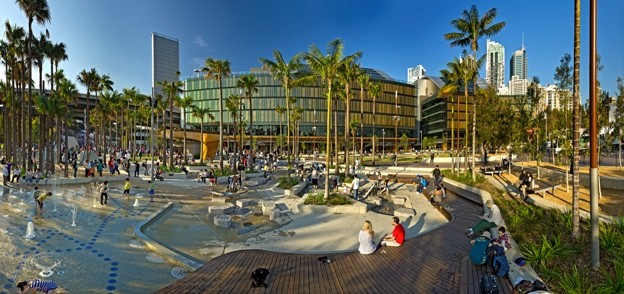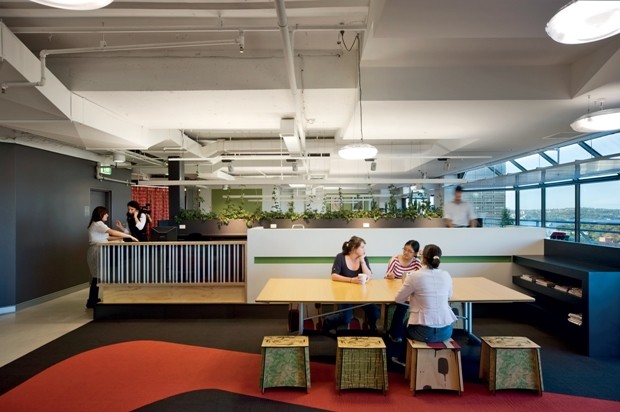In celebration of the launch of World Green Building Week, Architecture and Design was invited by the Green Building Council to join a tour of some of Sydney's most sustainable buildings.
The tour starts at 30 The Bond where we are met by our guides Ben Thomas from the Better Buildings Partnership and Robin Mellon, executive director of the Green Building Council Australia.
30 The Bond is currently occupied by Lend Lease and was designed by Lend Lease Design and Peddle Thorp Walker Architects. It was the first building in Australia to commit to achieving five stars under the Australian Building Greenhouse Rating system (now NABERS).
The main entrance of the building reveals its colonial history with its exposed internal sandstone walls which were originally made by convicts and which Thomas says now serve the function of providing added insulation.
The materials such as oxidised steel, recycled wharf timbers and patinated copper are intended to reflect the local environment and incorporate the site's maritime heritage.
From there the tour moves down the road to One Shelley Street with its attention grabbing façade 'diagrid' which provides support for the buildng and shading. The building which houses Macquarie Group was designed by architects Fitzpatrick + Partners and is owned by Brookfield Multiplex.
It has a 5 Star NABERS rating due to a range of energy saving initiatives including an escalator that slows down when no-one is using it, grey and black water recycling and it has achieved a 100 per cent increase to outside air provision over the Australian standard. The large sculptural artwork at the entrance of the building also acts as the exhaust from the car park.
It is then time to get on a mini bus as the tour heads to The Darling Quarter and the fjmt designed, Lend Lease developed set of two buildings including one occupied by the Commonwealth Bank which Mellon says is currently one of the 'greenest buildings in Australia'.

The Darling Quarter
The exterior of the building is highly efficient at controlling the optimal amount of daylight penetration while also controlling glare and heat load.
There is also an efficient tri-generation plant that generates electricity, heat and cooling with reduced carbon emissions, 1000 litre rainwater tank.
During construction around 88 per cent of on-site waste was recycled which takes into consideration the whole lifecycle of materials used.
Mellon describes the ideal to achieving long term successful sustainable outcomes as finding a balance.
"Good design, good technology and good behaviour- that's where the sweet spot is."
Back in the mini bus and the tour finds itself at one of the newest sustainable developments currently under construction, which is the 161 Castlereagh Street 50 storey development on the site of an 1860's Vial Coach factory.
The building has been designed by fjmt and is being developed by Grocon for the eventual tenancy of ANZ and Freehills.

161 Castlereagh Street
The building is registered to achieve a 6 Star Green Star Rating and has put in place initiatives to achieve this through the installation of a tri-generation plant with excess heat generated to be used for heating water; scheduled lighting; automated blinds and external sun sensors; rainwater harvesting and recycling of up to 95 per cent of demolition and construction waste.
From there we walk to the final stop on the tour which is the GreenHouse fitout- home to the Green Building Council of Australia's (GBCA) head office.
The shell of the building is a typical 1980's design with marble floor in the lobby and wood panel walls but as we take the lift up to the floor occupied by the GBCA, a modern open plan design office is revealed.
The fitout shows exposed ceilings and recycled mismatch eclectic furnishings as well as a balcony with views across Hyde Park. The kitchen has a compost bin complete with a worm farm which feeds the plants and growing wall scattered throughout the office.

GreenHouse reception, GBCA offices. Photography by Emma Cross Gollings
A raised floor air displacement system and CO2 sensors throughout the space mean air is supplied into occupied areas only. As a result, no supplementary air-conditioning is required.
The tour ends with the chief executive of the GBCA, Romilly Madew sitting with the group and discussing the events taking place in celebration of World Green Building Week including an open mic night as well as tours which are able to be downloaded by the public.
The map and fact sheet of the walking tour is available for download here.

